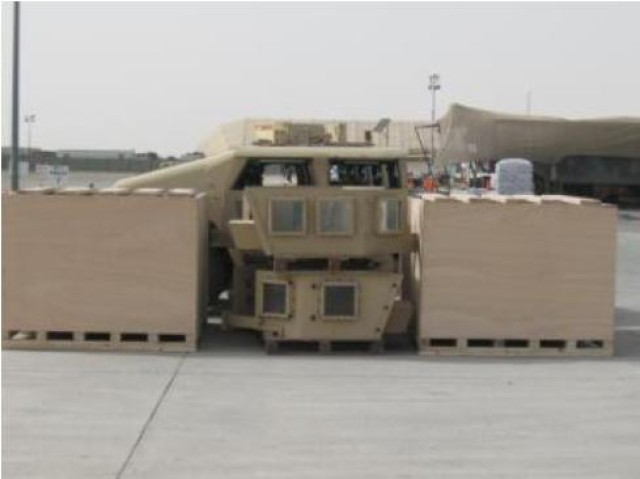The 2nd Battalion, 401st Army Field Support Brigade (2/401st AFSB), commanded by LTC Michael T. Wright, has well over 2,000 M1114 High Mobility Multipurpose Wheeled Vehicles (HMMWVs) in its footprint on Camp Arifjan.
Until recently, most of these HMMWVs had an uncertain future due to sub-sequent upgrades to the HMMWV family of vehicles and the introduction of more hardened vehicles such as the Mine Resistant Ambush Protected (MRAP) vehicle.
"HMMWVs in a Can" is just a humorous way of describing a Foreign Military Sales (FMS) program that presents the Battalion with the opportunity to put the M1114s back into productive use and to re-coup the Army's initial investment in the vehicles.
Currently, a total of over 1,500 HMMWVs have been identified for sale, the bulk of them to the Af-ghan National Police and the remainder to the Af-ghan National Army. To prepare the vehicles for sale, the Battalion first puts them through a Theater Pro-vided Equipment Refurbishment (TPER) and Battalion maintenance program to ensure the vehicles meet 10/20 standards, that is, operator and organizational-level maintenance.
Second, the Battalion prepares the vehicles for shipping. That is where the "can" comes in. Each HMMWV is stripped of its doors and Objective Gunner Protection Kit (OGPK). Then each HMMWV is carefully backed into a twenty-foot metal container, commonly known as a MILVAN.
It is such a tight squeeze that there are only about two inches of room to spare on either side of the Humvee, and the driver has to wiggle through the gunner's hatch to get out. Lastly, the vehicle is blocked and braced, tagged and labeled, and transported to the Sea Port of Embarkation. Doors and OGPK are packed in sepa-rate containers. The ratio of vehicle containers to components is 6:1.
So far, the Battalion has completed maintenance on 72 percent of the vehicles, and the first shipment has arrived at the Sea Port of Debarkation. A prelimi-nary estimate of the cost to process the HMMWVs indicates that the first "push" of 78 vehicles cost a little over $200,000.
That cost includes maintenance labor and parts, Basic Issue Items, packing materials, and shipping labor. The low cost per vehicle was around $1,500, and the high was over $5,000. Most HMMWVs cost between $2,000 and $3,000 to process.
Once complete, the benefits of the M1114 FMS project will be threefold: first, and most importantly, the Afghan National Army and Police will receive a fleet of HMMWVs which will greatly facilitate the Afghan security mission for many years to come. Second, the Battalion will free up much-needed space on Camp Arifjan in advance of the Responsible Drawdown. And third, the Army will recoup some of its cost to purchase and maintain the HMMWVs.




Social Sharing